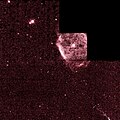NGC 40
| Right ascension | 00h 13m 01.015s[1][failed verification] |
|---|---|
| Declination | +72° 31′ 19.08″[1][failed verification] |
| Distance | 1,619[2] pc |
| Apparent magnitude (V) | 11.6[3] |
| Apparent dimensions (V) | 38″ × 35″[3] |
| Constellation | Cepheus |
| Designations | Bow-Tie Nebula, Caldwell 2, PN G120.0+09.8 |
NGC 40 (also known as the Bow-Tie Nebula and Caldwell 2) is a planetary nebula discovered by William Herschel on November 25, 1788, and is composed of hot gas around a dying star. The star has ejected its outer layer which has left behind a small, hot star.[4] Radiation from the star causes the shed outer layer to heat to about 10,000 degrees Celsius and become visible as a planetary nebula. The nebula is about one light-year across.[4] About 30,000 years from now, scientists theorize that NGC 40 will fade away, leaving only a white dwarf star approximately the size of Earth.[4]
Morphologically, the shape of NGC 40 resembles a barrel with the long axis pointing towards the north-northeast. There are two additional pairs of lobes around the poles, which correspond to additional ejections from the star.[5]
The central star of NGC 40 has a
Gallery
-
Image of NGC 40 by Amateur Astronomer
-
Optical image from the WIYN telescope
References
- ^ a b "NGC 40". SIMBAD. Centre de données astronomiques de Strasbourg. Retrieved 2006-12-22.
- S2CID 228063812.
- ^ ISBN 978-0-933346-97-0.
- ^ a b c "Chandra X-Ray Observatory". Retrieved 2007-06-05.
- .
- ^ .
- S2CID 237940344.



